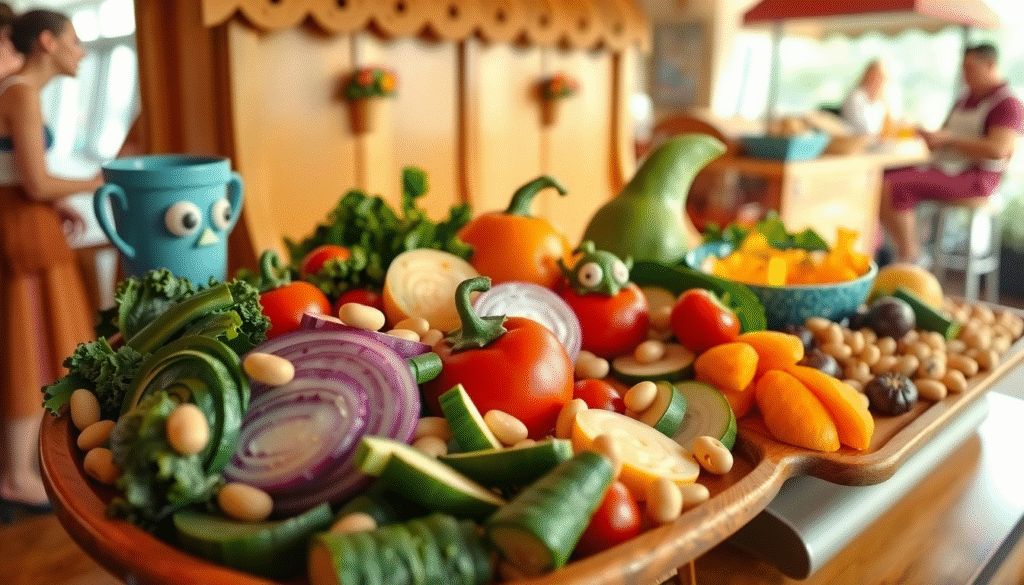
Here’s Olivia, the Health-Conscious Juggler. Olivia is 38, a project manager by day, a hiking enthusiast by weekend, and a snack negotiator by night. She’s juggling her career, her dog, and her health goals with the precision of a circus performer—except her cravings keep throwing pies at her face.
Olivia’s challenges? Oh, where to begin. She’s constantly hungry, her metabolism is slower than a sloth on vacation, and her bloating makes her jeans scream for mercy. But Olivia isn’t giving up. She’s discovered the secret weapon to outsmart her body’s sneaky tricks: GLP-1-boosting foods.
Let’s dive into Olivia’s journey and learn how you, too, can harness the power of GLP-1 to feel fuller, lose weight, and laugh at your body’s antics along the way.
What Is GLP-1 and Why Should You Care?
GLP-1, or glucagon-like peptide-1, is the unsung hero of your digestive system. This hormone slows digestion, regulates blood sugar, and keeps you feeling full—basically, it’s the body’s way of saying, “Hey, you’ve had enough pizza. Let’s chill.”
Medications like Ozempic mimic GLP-1 to suppress appetite and promote weight loss, but they can come with side effects (and a hefty price tag). The good news? Your body already makes GLP-1 naturally, and certain foods can help boost it without the need for injections or prescriptions.
How GLP-1 Works in Your Body
GLP-1 is like the body’s personal traffic controller for digestion and appetite. Here’s what it does:
- Slows Digestion: GLP-1 signals your stomach to take its time, which helps you feel full longer and prevents overeating.
- Regulates Blood Sugar: It stimulates insulin release and reduces glucagon production, keeping blood sugar levels steady.
- Promotes Satiety: GLP-1 communicates with your brain to say, “Hey, we’re good—no need for more snacks!”
By boosting GLP-1 naturally, you can mimic these effects without relying on medications.
Olivia’s Daily Struggles and How GLP-1 Foods Help
Constant Hunger and Cravings

Olivia’s struggle: “Why am I always hungry? I eat a salad, and my stomach’s like, ‘Cool, what’s next?’ Then I end up eating an entire loaf of garlic bread. Help!”
Protein-Rich Foods to Save the Day:
Protein is the ultimate multitasker when it comes to health and wellness. Not only does it help build and repair muscles, but it also plays a vital role in keeping your hunger in check and your energy steady. Protein-rich foods take longer to digest, which means they keep you feeling full and satisfied for longer periods—saving you from endless snacking and cravings. Additionally, protein helps stabilize blood sugar levels by slowing the absorption of carbohydrates. This is especially important for maintaining energy throughout the day and avoiding those dreaded mid-afternoon crashes. By incorporating protein into your meals, you’re not just feeding your body; you’re also giving it the tools it needs to burn fat, build lean muscle, and support metabolism. It’s like your secret weapon in the battle against constant hunger and energy dips.
- Lentils: Tiny powerhouses that offer about 18 grams of protein per cooked cup. Perfect for soups, stews, or salads.
- Chickpeas: Also known as garbanzo beans, these provide around 15 grams of protein per cooked cup. Hummus, anyone?
- Edamame: Young soybeans deliver 18 grams of protein per cooked cup. A great snack or addition to stir-fries.
- Tofu: 10–20 grams of protein per serving, depending on firmness.
- Tempeh: About 15 grams per serving, with a nutty flavor.
- Seitan: A whopping 25 grams per 3.5 ounces, made from wheat gluten.
- Quinoa: A complete protein with 8 grams per cooked cup. Versatile for salads, bowls, or as a side dish.
- Hemp Seeds: These pack 10 grams of protein per 3 tablespoons. Sprinkle them on smoothies, oatmeal, or salads.
- Chia Seeds: With 5 grams of protein per 2 tablespoons, they’re great for puddings or as a topping.
- Nuts and Nut Butters: Almonds, peanuts, and cashews provide 5–7 grams of protein per ounce. Nut butters are equally protein-rich.
- Beans: Black beans, kidney beans, and pinto beans offer 15 grams of protein per cooked cup.
- Spirulina: A blue-green algae that provides 8 grams of protein per 2 tablespoons and is loaded with nutrients.
- Green Peas: With 9 grams of protein per cooked cup, they’re simple yet effective additions to meals.
- Oats: About 6 grams of protein per half-cup dry. Perfect for breakfast or baking.
- Wild Rice: Contains 7 grams of protein per cooked cup and adds a nutty flavor to dishes.
- Brown Rice: Contains about 5.5 grams of protein per cooked cup. A hearty and nutty whole grain that’s perfect as a side dish or base for bowls.
- Black Rice (Forbidden Rice): Provides about 4 grams of protein per cooked cup and is rich in antioxidants, with a slightly sweet, nutty flavor.
- Red Rice: Nutrient-rich and chewy, with a nutty taste. A versatile choice that complements various meals.
- Arborio Rice: Offers about 11 grams of protein per 100 grams (raw). Ideal for creamy risotto dishes packed with flavor.
- Vegetables:
- Broccoli: offer 4–5 grams of protein per cooked cup.
- Spinach: offer 4–5 grams of protein per cooked cup.
- Brussels Sprouts: offer 4–5 grams of protein per cooked cup.
- Sweet Corn: Contains about 4.7 grams of protein per cooked cup. A sweet and versatile addition to meals.
- Asparagus: Offers approximately 4.3 grams of protein per cooked cup. Perfect for roasting or steaming.
- Artichokes: Provides around 4.2 grams of protein per medium artichoke. Great for dips or as a side dish.
- Mushrooms: Contains about 3.9 grams of protein per cooked cup. A flavorful and low-calorie option for stir-fries or soups.
- Collard Greens: Offers 5 grams of protein per cooked cup. A hearty green that works well in sautés or wraps.
- Mustard Greens: Contains 3.5 grams of protein per cooked cup. Adds a peppery kick to dishes.
- Swiss Chard: Provides 3.5 grams of protein per cooked cup. A colorful and nutrient-packed green.
Bloating Drama

Olivia’s struggle: “My gut is throwing a tantrum again. Yesterday, my jeans fit perfectly. Today, they’re screaming, ‘Nope, not today!’”
High-Fiber Foods to Tame the Rebellion:
Fiber is like the calming mediator your gut desperately needs. It slows digestion, allowing your body to absorb nutrients more effectively while keeping you fuller for longer—no snack attacks required. Fiber also improves insulin sensitivity, helping to balance blood sugar and avoid those wild energy swings that leave you reaching for the candy drawer. And let’s not forget its ability to tame bloating and irregular digestion, transforming your gut from a drama queen to a zen master. Incorporating high-fiber foods like lentils, raspberries, and broccoli into your meals is like giving your digestive system a spa day, promoting smoother digestion and a happier belly. Whether you’re battling bloating, cravings, or hunger, fiber has your back!
- Lentils: 15.6 grams of fiber per cooked cup. They’re your gut’s best friend.
- Black Beans: 15 grams of fiber per cooked cup. So versatile!
- Chickpeas: 12.5 grams of fiber per cooked cup. Fiber and flavor? Yes, please!
- Quinoa: 5 grams of fiber per cooked cup. Perfect for bowls and sides.
- Brown Rice: 3.5 grams of fiber per cooked cup. Simple and satisfying.
- Raspberries: 8 grams of fiber per cup. Sweet and healthy.
- Pears: 5.5 grams of fiber per medium pear. A snack that’s juicy and filling.
- Apples: 4.4 grams of fiber per medium apple. Crunch your way to happiness.
- Broccoli: 5 grams of fiber per cooked cup. Fiber-packed and versatile.
- Brussels Sprouts: 4 grams of fiber per cooked cup. Tiny and mighty!
- Sweet Potatoes: 3.8 grams of fiber per medium potato. Warm and comforting.
- Chia Seeds: 10 grams of fiber per 2 tablespoons. A superfood for your gut.
- Flaxseeds: 7 grams of fiber per 2 tablespoons. Great for smoothies or baking.
- Hemp Seeds: 3 grams of fiber per tablespoon. Tiny but impactful.
- Almonds: 3.5 grams of fiber per ounce. Crunch away!
- Avocado: 10 grams of fiber per medium avocado. Creamy and healthy.
- Popcorn: 3.5 grams of fiber per 3 cups, air-popped. Your snack savior.
Sluggish Metabolism

Olivia’s struggle: “My metabolism packed up and left years ago. I even sent it missing posters, but it just doesn’t care.”
Taste the Bitter Victory: Boost Your GLP-1 Naturally:
Bitter foods are like the overachievers of the culinary world—they might make you wince at first bite, but their benefits are worth every puckered face. These foods activate specialized gut receptors that naturally increase GLP-1 levels, helping to regulate blood sugar, slow digestion, and promote satiety. By giving your hunger hormones a little nudge in the right direction, bitter foods like arugula, kale, and dark chocolate (yes, chocolate!) can help you feel full longer while keeping cravings in check. Think of them as your gut’s secret weapon, fighting fat storage and improving digestion one bold bite at a time. So, while they may be bitter on the tongue, they’re oh-so-sweet for your wellness goals!
- Arugula: Spicy and packed with nutrients. Great in salads.
- Kale: A bitter green with superfood status. Versatile in recipes.
- Dandelion Tea: Earthy, soothing, and loaded with gut-friendly benefits.
- 85% Dark Chocolate: Slightly bitter but oh-so-satisfying.
- Radicchio: Vibrant and perfect for grilling or salads.
- Endive: Pairs beautifully with citrus or nuts in salads.
- Mustard Greens: Sharp and nutrient-packed for sautéing or soups.
- Bitter Melon: A unique fruit known for its health perks.
- Fenugreek Leaves: An Indian cooking staple with a bitter edge.
- Chicory Root: A coffee substitute rich in inulin, a prebiotic fiber.
- Broccoli Rabe: Bold and bitter, perfect for steaming or sautéing.
Energy Dips and Constant Hunger

Olivia’s struggle: “It’s 3 PM, and I’m so tired, even watching paint dry feels like too much effort.”Healthy Fats to Save the Day:
Goodbye, Cravings—Hello, Healthy Fats
Healthy fats are the unsung heroes of a balanced diet, providing energy, supporting brain health, and keeping your hunger in check. Unlike quick-burning carbs, healthy fats are digested slowly, ensuring you stay satisfied and energized for longer stretches. They’re also crucial for hormone production, including those that regulate hunger and blood sugar. Incorporating nutrient-dense sources like avocados, nuts, seeds, and coconut meat into your meals gives your body the tools it needs to stabilize energy levels, curb cravings, and promote overall wellness. Plus, these tasty options add rich flavor and texture to meals, proving that eating well doesn’t mean sacrificing enjoyment!
· Avocado: Creamy, nutrient-packed, and satisfying.
· Almonds: Crunchy and energizing. Perfect for snacking.
· Tahini: A sesame paste that’s rich, nutty, and ideal for dips or dressings.
· Walnuts: Packed with omega-3 fatty acids, these brain-boosting nuts are great for snacking or adding to salads.
· Pistachios: A fun, crunchy snack that’s rich in healthy fats and fiber.
· Cashews: Creamy and versatile, perfect for making dairy-free sauces or enjoying as a snack.
· Macadamia Nuts: Buttery and indulgent, these nuts are a great source of monounsaturated fats.
· Sunflower Seeds: Tiny but mighty, these seeds are rich in healthy fats and vitamin E. Sprinkle them on salads or oatmeal.
· Pumpkin Seeds: Also known as pepitas, they’re a crunchy, nutrient-dense snack loaded with healthy fats and magnesium.
· Flaxseeds: These tiny seeds are rich in omega-3 fatty acids and fiber. Add them to smoothies, oatmeal, or baked goods.
· Chia Seeds: Packed with healthy fats, fiber, and protein, they’re perfect for puddings or as a topping for yogurt.
· Hemp Seeds: A great source of omega-3 and omega-6 fatty acids, these seeds are perfect for sprinkling on salads or blending into smoothies.
· Olives: Whole olives are a fantastic source of monounsaturated fats and make a great snack or addition to dishes.
· Coconut Meat: Fresh or dried coconut meat is rich in healthy fats and adds a tropical twist to snacks or recipes.
Lifestyle Hacks to Boost GLP-1 Naturally
- Exercise Regularly: Physical activity increases GLP-1 levels and improves insulin sensitivity. Even a brisk walk can make a difference.
- Stay Hydrated: Drinking water before meals can help stimulate GLP-1 release and improve digestion.
- Eat Mindfully: Slowing down and savoring your meals allows your body to produce GLP-1 more effectively.
- Get Enough Sleep: Poor sleep can disrupt hormone regulation, including GLP-1 production.
The Role of Gut Health in GLP-1 Production
Your gut is home to trillions of bacteria that play a crucial role in GLP-1 production. Here’s how to keep your gut happy:
- Probiotic Foods: Fermented foods like yogurt, kimchi, and sauerkraut support a healthy gut microbiome, which can enhance GLP-1 secretion.
- Prebiotic Foods: Foods rich in inulin, like chicory root and garlic, feed the good bacteria in your gut, promoting GLP-1 production.
- Avoid Processed Foods: Highly processed foods can disrupt your gut microbiome and reduce GLP-1 levels.
Comparing Natural GLP-1 Boosting to Medications
While medications like Ozempic are highly effective at mimicking GLP-1, they come with potential side effects such as nausea, bloating, and fatigue. Natural methods, on the other hand, offer a sustainable and side-effect-free approach to boosting GLP-1. Here’s a quick comparison:
| Aspect | Medications | Natural Methods |
| Effectiveness | Rapid and potent | Gradual and sustainable |
| Side Effects | Possible nausea, fatigue | None |
| Cost | Expensive | Affordable |
| Accessibility | Prescription required | Available to everyone |
Fun Facts About GLP-1 Foods
- Dark Chocolate: The darker, the better! 85% dark chocolate is rich in antioxidants and bitter compounds that stimulate GLP-1.
- Avocado: This creamy fruit isn’t just delicious—it’s a GLP-1 powerhouse thanks to its healthy fats and fiber.
- Chia Seeds: These tiny seeds absorb up to 10 times their weight in water, creating a gel-like texture that slows digestion and boosts satiety.
Olivia’s GLP-1 Meal Plan
Here’s a sample day of eating for Olivia, packed with GLP-1-boosting foods:
Day 1: Packed with GLP-1-Boosting Foods
Breakfast: Quinoa Porridge
- Recipe: Cook 1/2 cup quinoa in 1 cup almond milk. Stir in 1 tablespoon almond butter, 1 tablespoon chia seeds, and top with 1/2 cup fresh raspberries.
Lunch: Kale and Chickpea Salad
- Recipe: Toss 2 cups chopped kale with 1/2 cup cooked chickpeas, 1/4 avocado (sliced), and 2 tablespoons tahini dressing. Add a sprinkle of sunflower seeds for crunch.
Snack: Edamame and Dark Chocolate
- Recipe: Steam 1 cup edamame and pair with a small square (about 10g) of 85% dark chocolate.
Dinner: Lentil Soup with Broccoli Rabe
- Recipe: Sauté 1/2 cup diced onion, 1 minced garlic clove, and 1/2 cup chopped carrots in a little bit of water or vegetable broth. Add 1 cup cooked lentils, 2 cups vegetable broth, and 1 cup chopped broccoli rabe (or broccoli). Simmer for 10 minutes. Serve with 1/2 cup cooked wild rice (can substitute with a different variety).
Dessert: Dandelion Tea and Dark Chocolate
- Recipe: Brew a cup of dandelion tea and enjoy with another small square of 85% dark chocolate.
Day 2: A Flavorful Feast
Breakfast: Berry Chia Pudding
- Recipe: Mix 3 tablespoons chia seeds with 1 cup almond milk and refrigerate overnight. Top with 1/2 cup mixed berries and a drizzle of honey.
Lunch: Quinoa and Black Bean Bowl
- Recipe: Combine 1 cup cooked quinoa, 1/2 cup black beans, 1/4 avocado, and 1/4 cup salsa. Add a handful of arugula for a bitter kick.
Snack: Pumpkin Seeds and Apple Slices
- Recipe: Pair 1/4 cup pumpkin seeds with 1 sliced apple.
Dinner: Tofu Stir-Fry
- Recipe: Sauté 1 cup cubed tofu with 1 cup mixed vegetables (broccoli, bell peppers, and snap peas) in tamari sauce. Serve over 1/2 cup cooked brown rice.
Dessert: Dandelion Tea and a Handful of Walnuts
Day 3: Comfort and Crunch
Breakfast: Savory Oatmeal Bowl
- Recipe: Cook 1/2 cup oats in water or almond milk. Top with 1/4 avocado, and a sprinkle of nutritional yeast.
Lunch: Spinach and Lentil Wrap
- Recipe: Spread 1 tablespoon hummus on a whole-grain wrap. Add 1/2 cup cooked lentils, 1 cup spinach, and shredded carrots. Roll it up!
Snack: Sunflower Seeds and Dark Chocolate
- Recipe: Enjoy 1/4 cup sunflower seeds with a small square of 85% dark chocolate.
Dinner: Chickpea and Kale Curry
- Recipe: Sauté 1/2 cup diced onion and 1 minced garlic clove in 1 tablespoon of vegetable broth or water. Add 1 tablespoon of curry powder, 1 cup cooked chickpeas, 1 cup chopped kale, and 1 cup crushed tomatoes. Simmer for 10–15 minutes, stirring occasionally. Serve over 1/2 cup cooked brown rice or quinoa for a hearty, flavorful meal.
Dessert: Dandelion Tea and a Small Handful of Pistachios
Day 4: Fresh and Filling
Breakfast: Avocado Toast with Hemp Seeds
- Recipe: Spread 1/4 avocado on a slice of whole-grain toast. Sprinkle with 1 tablespoon hemp seeds and a pinch of sea salt.
Lunch: Broccoli Rabe and Quinoa Salad
- Recipe: Toss 1 cup cooked quinoa with 1 cup steamed broccoli rabe, 1/4 cup pumpkin seeds, and a lemon-tahini dressing.
Snack: Chia Pudding with Dark Chocolate
- Recipe: Top leftover chia pudding with a small square of 85% dark chocolate.
Dinner: Tempeh Stir-Fry
- Recipe: Sauté 1 cup cubed tempeh with 1 cup mixed vegetables (zucchini, mushrooms, and bok choy) in tamari sauce. Serve over 1/2 cup cooked brown rice.
Dessert: Dandelion Tea and a Handful of Almonds
Day 5: A Nutrient-Packed Day
Breakfast: Spirulina Smoothie
- Recipe: Blend 1 cup almond milk, 1 frozen banana, 1 tablespoon spirulina powder, 1 tablespoon almond butter, and a handful of spinach.
Lunch: Lentil and Arugula Salad
Snack: Flaxseed Crackers with Hummus
- Recipe: Pair 5 flaxseed crackers with 2 tablespoons hummus.
Dinner: Seitan and Brussels Sprouts
- Recipe: Roast 1 cup Brussels sprouts with tahini and garlic. Sauté 1 cup sliced seitan and serve together with a side of quinoa.
Dessert: Dandelion Tea and a Small Handful of Cashews
Day 6: A Day of Delicious Variety
Breakfast: Wild Rice Breakfast Bowl
- Recipe: Combine 1/2 cup cooked wild rice with 1/4 cup almond milk, 1 tablespoon chia seeds, and 1/4 cup fresh blueberries.
Lunch: Chickpea and Spinach Soup
- Recipe: Sauté 1/2 cup diced onion and 1 minced garlic clove. Add 1 cup cooked chickpeas, 2 cups vegetable broth, and 1 cup spinach. Simmer for 10 minutes.
Snack: Almonds and Dark Chocolate
- Recipe: Enjoy 1/4 cup almonds with a small square of 85% dark chocolate.
Dinner: Tofu and Kale Stir-Fry
- Recipe: Sauté 1 cup cubed tofu with 1 cup chopped kale and 1/2 cup sliced mushrooms in tamari sauce. Serve over 1/2 cup cooked brown rice.
Dessert: Dandelion Tea and a Handful of Walnuts
Day 7: A Satisfying Finish
Breakfast: Tahini and Banana Toast
- Recipe: Spread 1 tablespoon tahini on a slice of whole-grain toast. Top with 1/2 sliced banana and a sprinkle of cinnamon.
Lunch: Quinoa and Broccoli Salad
- Recipe: Toss 1 cup cooked quinoa with 1 cup steamed broccoli, 1/4 cup sunflower seeds, and a lemon-tahini dressing.
Snack: Pumpkin Seeds and Apple Slices
- Recipe: Pair 1/4 cup pumpkin seeds with 1 sliced apple.
Dinner: Lentil and Sweet Potato Stew
- Recipe: Sauté 1/2 cup diced onion, 1 minced garlic clove, and 1/2 cup chopped carrots. Add 1 cup cooked lentils, 1 cup diced sweet potato, and 2 cups vegetable broth. Simmer until tender.
Dessert: Dandelion Tea and a Small Handful of Pistachios
A Bonus Dinner Recipe:
Dinner: Lentil and Sweet Potato Bake
Recipe: Combine 1 cup cooked lentils, 1 medium sweet potato (cubed), 1/2 cup chopped spinach, and 1 cup diced tomatoes in a baking dish. Add 1 teaspoon smoked paprika, 1 teaspoon dried thyme, and a pinch of salt. Bake at 375°F (190°C) for 25–30 minutes, or until the sweet potato is tender. Serve warm with a side of steamed broccoli.
Simple Hummus Recipe
Ingredients:
- 1 can (15 oz) or 1/1/2 cup chickpeas (drained and rinsed)
- 1/4 cup tahini (smooth sesame paste)
- 1 small garlic clove (minced or grated)
- 2–3 tablespoons fresh lemon juice (adjust to taste)
- 1/4 teaspoon sea salt (or to taste)
- 2–3 tablespoons water (to adjust consistency)
Optional Add-Ins:
- 2 tablespoons roasted red peppers
- A pinch of ground cumin or smoked paprika (for a subtle flavor boost)
Instructions:
- In a food processor or blender, combine the chickpeas, tahini, garlic, lemon juice, and sea salt.
- Blend until smooth, adding water 1 tablespoon at a time to reach your desired consistency.
- Taste and adjust seasoning with additional salt or lemon juice if needed.
- (Optional) sprinkle with paprika or cumin before serving.
Enjoy your hummus as a dip for veggies, spread on wraps, or paired with whole-grain crackers!
Balsamic Vinaigrette
Ingredients:
- 1/4 cup balsamic vinegar
- 2 tablespoons Dijon mustard
- 1 tablespoon maple syrup (optional, for a touch of sweetness)
- 1 teaspoon nutritional yeast (optional, for added depth of flavor)
- 1/2 teaspoon dried oregano
- 1/2 teaspoon dried basil
- 2–3 tablespoons water (to adjust consistency)
- A pinch of sea salt and freshly ground black pepper (to taste)
Instructions:
- In a small bowl or jar, combine the balsamic vinegar, Dijon mustard, maple syrup, nutritional yeast, oregano, and basil.
- Whisk or shake well until all the ingredients are fully blended.
- Gradually add water, 1 tablespoon at a time, until the dressing reaches your desired consistency.
- Season with salt and pepper to taste.
- Store in an airtight container in the refrigerator for up to a week. Shake well before each use.
This vinaigrette is tangy, flavorful, and perfect for salads, roasted veggies, or grain bowls.
Lemon-Tahini Dressing
- Tahini: 1/4 cup (smooth and creamy sesame paste).
- Fresh Lemon Juice: 2–3 tablespoons (adjust to taste).
- Water: 2–4 tablespoons (to thin the dressing to your desired consistency).
- Garlic: 1 small clove (minced or grated).
- Honey or Maple Syrup: 1 teaspoon (optional, for a touch of sweetness).
- Salt: 1/4 teaspoon (adjust to taste).
- Optional Add-Ins: A pinch of cumin or smoked paprika for extra flavor.
- To make it, whisk all the ingredients together in a bowl until smooth and creamy. Adjust the water and seasonings as needed. This dressing pairs beautifully with salads, roasted veggies, or grain bowls!
Basic Seitan Recipe
Ingredients:
- 1 cup vital wheat gluten
- 3 tablespoons nutritional yeast (optional, for flavor)
- 1 teaspoon garlic powder
- 1 teaspoon onion powder
- 3/4 cup vegetable broth (or water)
- 2 tablespoons soy sauce (or tamari for gluten-free)
For the Cooking Broth:
- 4 cups vegetable broth
- 2 tablespoons soy sauce
- 1 teaspoon garlic powder
Instructions:
- Mix Dry Ingredients: In a large bowl, combine the vital wheat gluten, nutritional yeast, garlic powder, and onion powder.
- Add Wet Ingredients: Gradually stir in the vegetable broth and soy sauce. Mix until a dough forms.
- Knead the Dough: Knead the dough for about 2–3 minutes until it becomes elastic. Let it rest for 5 minutes.
- Shape the Seitan: Divide the dough into smaller pieces or shape it into a loaf, depending on how you plan to use it.
- Prepare the Cooking Broth: In a large pot, bring the vegetable broth, soy sauce, and garlic powder to a simmer.
- Cook the Seitan: Add the seitan pieces to the simmering broth. Cover and simmer gently for 45–60 minutes, flipping the pieces halfway through. Avoid boiling, as this can make the seitan rubbery.
- Cool and Use: Let the seitan cool in the broth before using it in your favorite recipes. It can be sliced, shredded, or cubed for various dishes.
This recipe is versatile, and you can customize the seasonings to suit your taste.
The End of the Buffet Line

GLP-1-boosting foods are the ultimate cheat code for outsmarting your hunger hormones. Whether you’re battling cravings, bloating, or sluggish energy, these foods can help you feel fuller, lose weight, and reclaim your health—no injections required.
So, the next time your stomach tries to sabotage you, grab some lentils, kale, or dark chocolate and remind your body who’s boss. You’ve got this!
Sources for Further Reading
Healthline: Foods That Increase GLP-1 Levels
Supplement Clarity: Best Foods and Supplements That Raise GLP-1 Levels
GoodRx: Foods and Supplements That Increase GLP-1 Naturally
Supplement Clarity: Best Foods and Supplements That Raise GLP-1 Levels Healthline: Foods That Increase GLP-1 Levels
In case you’re a ‘just give me a pill’ type of person and have the budget to explore supplements, here are a few sponsored products containing ingredients that might help support your goals. Remember, while supplements can be a useful addition, they work best when paired with a healthy lifestyle. So don’t skip out on the natural tips and strategies I’ve shared—your body will thank you!
